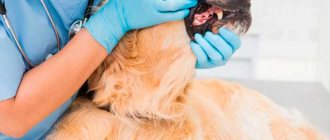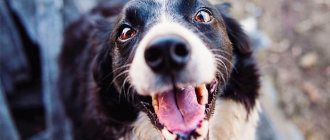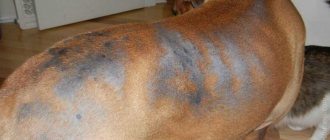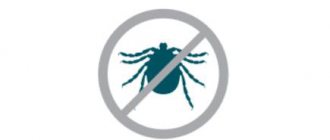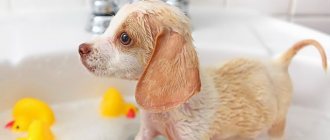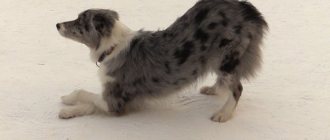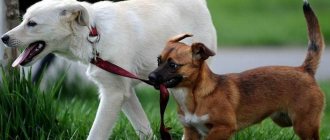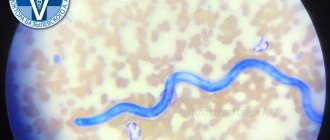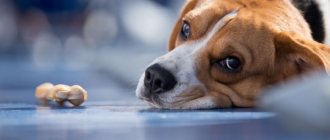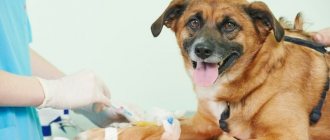02/05/2019 Drozd Nikolaevich Animals
Dogs, just like people, are susceptible to dental problems. Tooth decay in dogs is common. If it is not detected in time, it can lead to disruption of the animal’s internal organs. With dogs of hunting breeds, where the capture of prey with teeth plays a huge role, the situation becomes even more aggravated, because caries will cause its weakening. How to recognize caries and how to treat it?
Symptoms of the disease
Signs of caries in dogs depend on the degree of advanced disease. At first, you may notice dark spots on your dog's teeth. An unpleasant putrid odor is heard from the mouth. Over time, cavities will appear into which food will begin to clog. Increased salivation and difficulty chewing food also indicate that your pet has dental problems.
If the destruction affects the nerve endings, the dog will experience severe pain, whine, and refuse to eat. During examination, veterinary dentists may detect gum swelling and redness. Teeth affected by caries begin to loosen.
Symptoms and diagnosis of the disease
Decay processes in one or several teeth at once arise as a result of multiple causes. Without treatment, tooth loss occurs, and a void forms in the place of the lost tooth. The basic signs of the development of caries in a dog are:
- unpleasant repulsive odor from the mouth;
- increased secretion of salivary secretions;
- change in eating habits - the animal prefers soft food, in some cases, with severe pain, the dog loses appetite;
- pain in the affected area, characterized by anxiety in the dog, especially when the owner tries to inspect the mouth;
- change in the shade of the affected tooth (black dots or a complete change in color of the entire surface of the affected area are noted).
The putrefactive-destructive process (caries) does not develop at lightning speed. It is preceded by several stages. At the first stages of development, stains appear on the enamel of the teeth, then the superficial and middle stages develop. It ends with tooth destruction, when only removal can help.
The appearance of characteristic signs is a reason to immediately contact a veterinary clinic. The doctor will conduct an examination and prescribe a number of necessary tests. Diagnosis of caries is not difficult. Laboratory tests are prescribed, a blood test is especially important. The results obtained make it possible to assess the degree of neglect of the pathology - the presence of inflammation in the body. Sanitation of the oral cavity is carried out during an examination at a veterinary hospital, and in case of urgent need, the affected tooth of the dog is removed.
Veterinary dentistry
In most cases, the owner himself can detect caries in a dog. This does not require the help of a doctor. But if its signs have been identified, you need to contact a specialized city veterinary clinic, where, in addition to a visual examination, an x-ray will be prescribed. Based on the results obtained, a treatment regimen is prescribed. The prognosis for superficial damage to teeth is usually positive. In severe cases, surgical intervention is resorted to.
Treatment should be carried out in a clinic that offers a wide range of veterinary dental services:
- treatment of teeth affected by caries;
- removal of tartar by ultrasonic cleaning;
- removal of baby and molar teeth;
- teeth cleaning.
Treatment of caries in dogs
Treatment of caries should be carried out by a medical specialist. In case of superficial damage to the tooth, its surface is cleaned and a solution of silver nitrate is applied to stop the progression of the pathology. In order to determine how far the destruction process has gone, the tooth is treated with a special substance that stains the affected tissue.
In case of deep destruction, tooth filling may be required using cement, plastics or composite materials. The cost of such a procedure depends on the clinic, the material used to fill the cavity and the use of anesthesia, which can amount to a decent amount.
If the tooth cannot be saved, it is removed. To prevent caries in your pet, it is necessary to follow disease prevention measures.
Treatment
If an animal has a tooth that shows signs of caries, it should be shown to a veterinarian, who will tell you how to treat caries in a dog. Self-medication is unacceptable. In case of minor damage, when destruction and inflammation have not affected the deep layers and nerve, the tooth will have to be filled. If it is not possible to correct the problem surgically, the carious cavity will have to be regularly treated after each feeding of the dog.
Chlorhexidine, Rotokan, and calendula tincture are suitable as antibacterial agents. If an alcohol infusion is used, it must be diluted with water. For dental treatment in dogs, good results are achieved using the Metrogyl Denta gel. The composition should be applied to the dog’s teeth that show signs of caries.
When a tooth is completely destroyed, it must be removed. Such manipulations are performed under general anesthesia. After surgery, the dog's mouth must be treated daily with special solutions. If the wound heals, no auxiliary medications will be required. If suppuration occurs, antibiotic injections are prescribed.
Symptoms of caries
The initial stage of the disease, as a rule, is not characterized by the presence of pronounced symptoms, and that is why it often goes unnoticed. As the disease progresses, it provokes the appearance of the following clinical signs:
- sharp unpleasant odor from the mouth;
- blackening of the tooth surface;
- the appearance of cavities of different sizes in the teeth;
- food particles accumulate in the hollows and gradually rot;
- constant release of excessive amounts of salivary fluid;
- there are obvious disturbances in the chewing process;
- swelling of the gums around the tooth;
- severe pain during palpation;
- teeth may begin to loosen.
If caries has not had time to spread greatly and damage the tooth structure, it is treated with a special silver solution. If the disease has reached a more advanced stage, mechanical removal of diseased teeth is necessary.
Causes of caries
The exact causes of caries have not yet been studied. Under the influence of organic acids, demineralization of tooth enamel and damage to hard tooth tissue occurs. Violation of the protective layer of enamel can be caused by:
Changes in hard dental tissues in dogs can be caused by the fact that dogs are given thermally processed food, they chew hard foods less, resulting in a disruption of the natural process of cleaning teeth from plaque and tartar.
Another reason lies in heredity. In addition, it is worth noting that the incidence of pathology in representatives of small breeds is 15-35% higher than in medium and large dogs.
Poor nutrition can lead to dental problems. If a dog's diet is dominated by a large amount of carbohydrates and there is a deficiency of minerals, this will negatively affect the condition of its teeth.
Caries in a dog can appear against the background of metabolic disorders, after severe infectious diseases, or in the case of age-related degenerative processes.
Causes of the disease
The main causes of caries can be divided into two main types:
- Mechanical. Tooth decay occurs much more often in older dogs than in younger dogs. This occurs due to enamel defects - the entry point for infection. The most common causes of defects are: careless removal of tartar, gnawing on very hard bones and other objects.
- Chemical. This is a change in the chemical composition of saliva, as a result of which aggressive acids are formed in the oral cavity, which have a destructive effect on the enamel.
There are a number of provoking factors, the presence of which accelerates the onset of the disease:
- Hereditary pathologies in the development of teeth and skull bones (malocclusion).
- Features of the breed. Representatives of small breeds are more likely to have similar problems.
- Deficiency in the diet of minerals necessary for dental health (calcium, potassium, fluorine, phosphorus, chlorine). This is especially dangerous in childhood, during the formation of dental tissue.
- Decreased general and local immunity as a result of past infections.
- Diseases of the gastrointestinal tract, rickets, metabolic disorders.
- Degenerative changes in old age. This is especially true for the composition and quality of enamel.
- Living in an area with poor environmental conditions.
- The presence of sweet foods in the diet, which is the main cause of disruption of the acid-base balance of saliva.
Prevention
As you know, it is easier to prevent a disease than to deal with its difficult treatment later. This also applies to caries in dogs. To keep your pet's teeth healthy and strong for as long as possible, it is necessary to properly care for them. Not every owner has the opportunity to brush their dog’s teeth after feeding.
However, if you feed your animal raw bones and special biscuits for dogs, caries can be prevented, because this food takes on the role of a toothbrush and cleans plaque from the teeth. To clean teeth from plaque, you can also let your pet chew on special chewing toys. You can buy them at any pet store.
The dog's diet should consist of high quality food, which contains a sufficient amount of vitamins and microelements. It is important to take your pet to the veterinarian regularly. If tartar is found on the dog’s teeth, it is recommended to remove it without waiting for the situation to worsen.
Disease prevention
Prevention of caries in dogs consists of eliminating factors that provoke the disease. There are also certain precautions by which the disease can be prevented, namely:
- use only high-quality feed, exclude sweet foods from the diet;
- ensure that the diet contains a sufficient amount of minerals that affect the quality of enamel;
- periodically carry out oral hygiene - brushing teeth, removing tartar, treating with antiseptic drugs;
- Promote natural teeth cleaning by purchasing special hard chewing toys for your dogs. It is allowed to give non-tubular raw bones for chewing;
- It is advisable to periodically take your pets to the veterinarian for an examination of the oral cavity.
Dental health is an essential part of keeping your dog fit. All systems of the body are interconnected, so disruption of the functioning of any organ immediately negatively affects the activities of the rest.
source
Brushing a dog's teeth: what to use and how often to do the procedure
It is advisable to use special products to clean your dog's teeth. Toothpastes that are intended for humans should be discarded, because they can harm animals.
The procedure will require special brushes and anti-plaque sprays. The best brushes to use are those with regular bristles or rubber teeth. You can also use devices that fit on your finger.
How often can this procedure be performed? It all depends on the breed of the dog. As mentioned above, small breeds are more susceptible to caries, so their oral cavity will have to be looked after regularly.
Brushing your teeth is a procedure that will not be very pleasant for a dog, so the animal will have to be accustomed to it from an early age.
Preventive actions
To prevent the occurrence of dental diseases, it is necessary to teach the dog from an early age to perform oral hygiene procedures - brushing teeth, removing tartar. Manufacturers of dog food take into account the needs of animals of different ages for mineral supplements, developing the size and density of the pieces, depending on the breed. Therefore, using high-quality food helps prevent tooth decay.
In order to ensure the natural process of cleaning teeth from plaque and strengthening the jaws, the dog is given bones and pressed cartilage, which can be purchased at a pet store. The animal must be periodically taken to a veterinary clinic for examination, especially representatives of breeds that are at risk - decorative dogs, animals with congenital jaw abnormalities, old and sick animals.
Attentive attention to the condition of the pet’s oral cavity will prevent the appearance of caries or its development at an early stage and save the animal’s teeth.
source
Cleaning your dog's teeth: useful tips
- To brush an animal's teeth, it must be restrained. If the dog is large, it is easier to carry out the procedure by sitting it on the floor. A small dog can be placed on the table.
- If the animal reacts violently to such manipulations, it needs to be calmed and distracted.
- It is advisable to start brushing with the distant teeth.
- Once your pet gets used to brushing the outside of the teeth, you can begin cleaning the inside of them.
- You should not try to clean all your teeth at once. The animal must be gradually accustomed to this procedure, each time covering more and more teeth. If the dog does not allow you to open its mouth, you should not force it, because this will frighten the animal even more.
- After the cleaning process is completed, your pet must be rewarded with his favorite treat.
